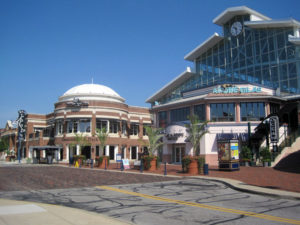Click on PLAY>>>above to view Ken’s welcome video to this month’s blog.
I returned recently from a trip to California and on the drive home, I was surprised to see that our local mall had been reduced to a pile of rubble while we were out of town. There still remained some signs and the main entrance portal but most of it and the adjoining theater had met their match with bulldozers and wrecking balls. Of course, this really didn’t happen in the week that we were away. The mall’s closing started several years ago as store after store began closing and the crowds that used to populate the court and restaurants got smaller and smaller. In the meantime, downtown shopping areas in cities big and small are beginning to thrive thanks to a change in customer attitudes toward shopping in a town center atmosphere where you can park in front of the store and so in or wander up and down the streets as was the custom many years ago.

Easton Town Center, Columbus
I realized recently that in just a five-mile radius of my home three major shopping malls had closed and been torn down in the past 3-4 years. Replaced by power centers where customers can park in front of their destination and get in/out quickly or visit one of the several restaurants (from fine dining to casual) that also drive traffic to the area. The same holds true around the country, where new shopping “centers” like Eaton Town Center in Columbus or Mooresville, NC, attract new stores, restaurants and people every day. The customers have changed the way they shop. Some might say they have just gotten back to way our parents shopped. Major cities are discovering that rebuilding and refurbishing downtown areas has great appeal to younger shoppers and these have become hubs of activity around the country. Developers and retailers realized this and have profited well in the new (old?) environments. Department stores on the other hand still are tied like “anchors” to the traditional mall locations. No wonder they continue to be challenged.
It all starts with continuing to monitor the customer attitudes and behaviors and adjusting the plans accordingly. These new town centers are a brand within themselves and the customers love the results. The same holds true in other industries and product categories. Take photo taking for example. The arrival of digital was not unpredicted. Once this category was one of the most profitable in consumer products and services and retailers took advantage of the higher margins and multiple shopping trips to build traffic to their
stores. Kodak recognized this early on and was one of the first to introduce affordable digital cameras and an online service to save and edit your new digital photos. However, with such a history and profit model tied in to film and developing, the company struggled to keep up with the fast changing world of photography. This opened the door for new brands like Shutterfly and Snapfish to provide exciting photo services and products online that not only encouraged more photo taking by customers but also gave them new ideas on how to enjoy the pictures long after the event. Most retailers now offer these services online and it’s not surprising that the online photo sites look amazingly like Shutterfly’s site. (In fact, they provide the service tot the stores in a turnkey fashion, while still providing the traffic building option of in-store pickup.
Just as Facebook and Instagram have made photos a part of our communications, Shutterfly provides new ways to keep your photos alive and visible in everything from photo books to tee shirts to blankets. Meanwhile, Kodak digital cameras are almost non-existent on the shelves of most retailers, their Easy Share program has disappeared, and the company continues to fade.
It all starts with the customer and keeping in touch with them. Then refining and building a brand strategy that takes advantage of the changes in attitudes and behaviors. The regional malls aren’t as easy to move away from and many have added “restaurant rows” to generate more of a town center feeling. But aside from a place for teens to hang out at, or an air-conditioned walking track for many seniors for their morning exercise, their reason for being has faded. When the first malls appeared in my hometown of Detroit, the primary benefit was a warm place to shop in the winter. Here in Florida, it was a cool place to shop to get away from the hot sun and humidity. Customers don’t seem to value these benefits as much any more. They want an interesting, convenient place to shop and a brand that meets their needs of today.

Recent Comments